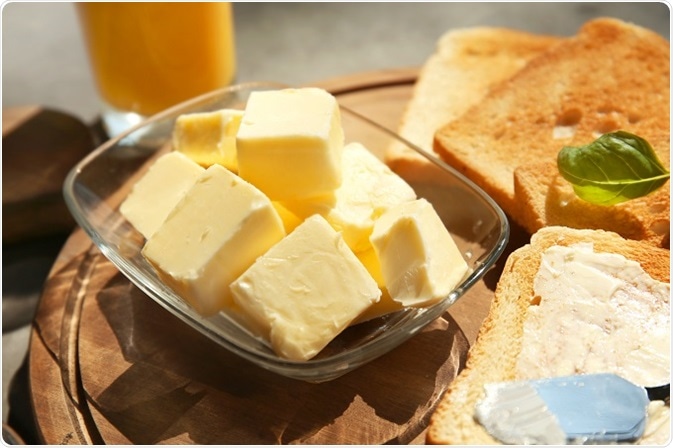Site Under Development, Content Population and SEO, Soft Launch 1st January 2020
Butter is a dairy product containing a large amount of edible fat. It is prepared by churning the cream obtained from milk. Butter may be obtained in a semi-solid form by whipping the cream. The standard proportion of butter to milk is 1:20. The amount of butter obtained in this process varies with the milk quality and fat content. Nowadays, the skimmed milk is utilized in various products and its importance has greatly increased.

Butter consists of 1%–2% milk , 16%–17% of water, 80%–82% of milk fat, and perhaps about 1%–2% of salt which is added directly into it. It also contains calcium, phosphorus, vitamins A, D, and E, and proteins. Lactones, diacetyl, methyl ketones, dimethyl sulphide, and fatty acids are the factors that add flavour to butter. Butter without the salt is also referred to as sweet butter.
The presence of carotene in natural butter is a source of important nutrition for human beings. Carotene benefits various parts of the body. It promotes cell regrowth and repair, protecting the body from various infections.
In addition, vitamin A is fat soluble and found enormously in butter, which is easily absorbed and benefits the skin, eyes, mouth, throat, and urinary and digestive tracts. It can improve cell regrowth and renovation, as well as enhance the immune system by encouraging lymphocytes production.
The consumption of butter on a regular basis in moderate amounts is beneficial to health as it provides several necessary minerals and vitamins essential for healthy living. It contains, for instance, vitamins A and D which are required for the proper development of the brain and nervous system, the skeleton, and many physiological processes. Also, butter helps in the proper functioning of many other parts of the body.
Conjugated linoleic acid (CLA) is a fatty acid found richly in butter made from grass-fed cows. CLA has been considered a health supplement for an individual. It can reduce total body fat content and can, therefore, lower the risk of obesity. A study on the effect of CLA in reducing body fat mass in humans concluded that an intake of 3.4 grams of CLA per day for 12 consecutive weeks is capable of lowering the fat content of the body appreciably in obese humans.
There are a few contradictory studies that show butter intake is a risk factor in causing human obesity. Such studies indicate only that the fat deposition in the body due to the excessive intake of butter and other fat-rich milk products promotes weight gain and thereby obesity.
Although butter has many health benefits, it is chiefly composed of fats which can cause many undesirable problems if consumed in excess. These include obesity, hypertension, heart disease and cancer. It is also possible that the use of white flour in most situations where butter is consumed is the primary culprit in causing obesity and linked complications. As in most cases, a moderate intake of butter will obviate most of the health risks ascribed to it, including a high level of bad cholesterol.
This is especially so in individuals who already have heart disease or high blood pressure. They may need to carefully restrict their intake of butter, or even avoid it completely for a period.
The continuous intake of butter in high quantities may also result in type 2 diabetes. The high fat level in the blood will affect insulin production in the β cells which results in the occurrence of diabetes.
Overall, however, there is no question that a limited quantity of butter taken on a regular basis is highly beneficial for health.